Erken Apparel International manufactures clothing items around the world. It has currently contracted with a U.S. retail
Question:
Erken Apparel International manufactures clothing items around the world. It has currently contracted with a U.S. retail clothing wholesale distributor for men’s goatskin and lambskin leather jackets for the next Christmas season. The distributor has distribution centers in Indiana, North Carolina, and Pennsylvania. The distributor supplies the leather jackets to a discount retail chain, a chain of mall boutique stores, and a department store chain. The jackets arrive at the distribution centers unfinished, and at the centers the distributor adds a unique lining and label specific to each of its customers. The distributor has contracted with Erken to deliver the following number of leather jackets to its distribution centers in late fall:

Erken has tanning factories and clothing manufacturing plants to produce leather jackets in Spain, France, Italy, Venezuela, and Brazil. Its tanning facilities are in Mende in France, Foggia in Italy, Saragosa in Spain, Feira in Brazil, and El Tigre in Venezuela. Its manufacturing plants are in Limoges, Naples, and Madrid in Europe and in Sao Paulo and Caracas in South America. Following are the supplies of available leather from each tanning facility and the processing capacity at each plant (in pounds) for this particular order of leather jackets:
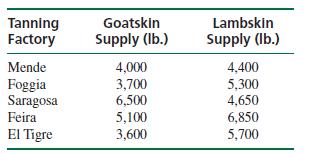
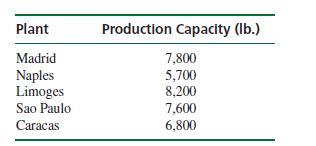
In the production of jackets at the plants, 37.5% of the goatskin leather and 50% of the lambskin leather is waste (i.e., it is discarded during the production process and sold for other byproducts). After production, a goatskin jacket weighs approximately 3 pounds, and a lambskin jacket weighs approximately 2.5 pounds (neither with linings, which are added in the United States).
Following are the costs per pound, in U.S. dollars, for tanning the uncut leather, shipping it, and producing the leather jackets at each plant:
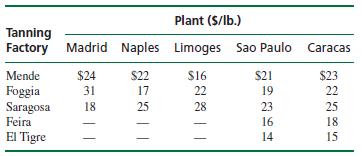
Note that the cost of jacket production is the same for goatskin and lambskin. Also, leather can be tanned in France, Spain, and Italy and shipped directly to the South American plants for jacket production, but the opposite is not possible due to high tariff restrictions (i.e., tanned leather is not shipped to Europe for production).
Once the leather jackets are produced at the plants in Europe and South America, Erken transports them to ports in Lisbon, Marseilles, and Caracas and then from these ports to U.S. ports in New Orleans, Jacksonville, and Savannah. The available shipping capacity at each port and the transportation costs from the plants to the ports are as follows:

The shipping costs ($/lb.) from each port in Europe and South America to the U.S. ports and the available truck and rail capacity for transport at the U.S. ports are as follows:
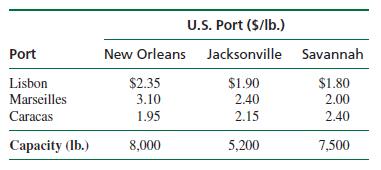
The transportation costs ($/lb.) from the U.S. ports to the three distribution centers are as follows:
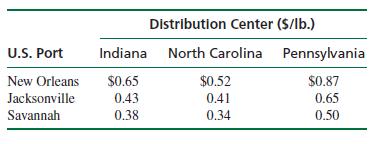
Erken wants to determine the least costly shipments of material and jackets that will meet the demand at the U.S. distribution centers. Develop a transshipment model for Erken that will result in a minimum cost solution.
Step by Step Answer:






